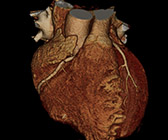What is Positron Emission Tomography?
Positron emission tomography, also called a PET scan, is a nuclear medicine exam that produces a three dimensional image of functional processes in the body. A PET scan uses a small amount of a radioactive drug to show differences between healthy and diseased issue. The diagnostic images produced by PET are used to evaluate a variety of diseases.
 What are some common uses of PET?
What are some common uses of PET?
- to detect cancer
- to evaluate the heart for:
- blood flow
- signs of coronary artery disease
- heart function
- to evaluate the brain for:
- memory disorders
- brain tumors
- seizure disorders
How should I prepare for this procedure?
PET is usually done on an outpatient basis. You should:
- wear comfortable clothes
- not eat for four to six hours before your scan
- drink plenty of water
- consult with your doctor regarding the use of medications before the test
What should I expect from this procedure?
- You receive an intravenous (IV) injection of the radioactive substance. However for some patients, you may be asked to inhale the substance.
- The radioactive substance will then take approximately 30 to 90 minutes to travel through your body and be absorbed by the tissue under study. During this time, you will be asked to rest quietly and avoid significant movement or talking, which may alter the localization of the administered substance.
- You will be positioned on the PET scanner table and be asked to lie still during your exam.
- Scanning takes 30 to 45 minutes.
- Some patients who are being evaluated for heart disease may undergo a stress test in which PET scans are obtained while they are at rest, and again after undergoing the administration of a pharmaceutical to alter the blood flow to the heart.
- Usually, there are no restrictions on daily routine after the test. You should drink plenty of fluids to flush the radioactive substance from your body.
What will I experience during the procedure?
- If given an intravenous injection, you will feel a slight needle prick. However, you will not feel the substance in your body.
- You will be made as comfortable as possible on the exam table before you are positioned in the PET scanner for the test.
- You will hear buzzing or clicking sounds during the exam.
- Patients who are claustrophobic may feel some anxiety while positioned in the scanner.
- Some patients find it uncomfortable to hold still in one position for more than a few minutes.
For more information on this topic, please visit www.Radiologyinfo.org.


 What are some common uses of PET?
What are some common uses of PET?
